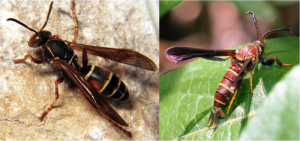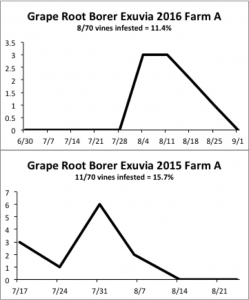During the fall and winter months of 2016-17 the NJAES Tree Fruit Working Group put together a grower survey with the objective of NJ tree fruit growers ranking various tree fruit research and extension activities done by Rutgers/NJAES. The survey consisted of separate discipline or program areas with rankings for each area. A first draft survey was vetted using input from a small grower advisory group in southern counties, and again at the Hershey meetings by the NJ State Horticultural Society board of directors. Comments from the 2 advisory meetings were incorporated into the survey prior to it being given out at the South Jersey Fruit Meeting (February 16, 2017) and the North jersey Fruit Meeting (March 1, 2017). A total of 34 responses were collected, representing 12 counties, plus 1 out of state grower. NJ responses represented 2,480 acres of tree fruit production. The survey combined stone fruit and pome fruit activities under most discipline areas; so tabulated results are combined under both crop types. [Read more…]
Grape Root Borer – Do I Need to Treat?
Dean Polk, Statewide Fruit IPM Agent and Dr. Anne Nielsen, Extension Specialist in Fruit Entomology
A number of growers have recently asked about treatments for grape root borer. Grape root borer (Vitacea polistiformis Harris) is a comparatively large clearwing moth. The adults can resemble Polistes wasps, and can often be confused with these insects, especially since it is often easier to see a wasp in a vineyard than an adult grape root borer. See the images that compare the 2 insects below in Figure 1.

Figure 1. Polistes wasp on left, compared to male grape root borer on right. Credits Hermann 2012 and Copeland 2012.
One important difference is that grape root borer (GRB) larvae feed inside grape roots, while wasp larvae do not. Although the grape borer is more of a southern pest, it is present in New Jersey and can be a pest that does significant damage. Adult females lay eggs on the vine surface and on weeds near the crown. Shortly after hatching the larvae enter the crown and central root system, boring into the roots where they can last for 2 years. When the larvae mature, they exit the wood and pupate close to the soil surface where they emerge from early July through August. GRB is not considered an economic pest until about 5% of the vines are infested. This is determined by examining the bases of numerous vines at weekly intervals for signs of adult emergence, or pupal cases (exuvia), throughout the summer, see Figure 2. Pheromone traps can also be used to measure adult emergence, but since they attract moths from both the surrounding woods and vineyards, they are practically useless to tell us what is going on in any specific vineyard. Counting pupal cases is labor intensive, but does tell us if the vineyard is or is not truly infested.

Figure 2. Pupal case from newly emerged adult GRB.
During 2015 -’16 we monitored 2 plantings at each of 9 vineyards. During that time we found 3 vineyards that had populations of GRB that merited treatment, or were above the 5% infestation level. While infestation levels can change over time, this does tell us a few things about GRB in NJ. First, about 33% of the vineyards we sampled had economic populations of GRB. Therefore growers need to determine if they indeed have GRB populations that merit treatment prior to actually doing a GRB treatment. Secondly most GRB adults emerged from the soil a little later than we first thought. Counting the pupal cases over time, we can get an emergence curve as in Figure 3. This vineyard does merit treatment, since the total vines infested is over 5%. Most of the insects that emerged peaked in late July and early August.

Figure 3. GRB exuvia counts over time Farm A, 2015, ’16.
Treatments: If the vineyard has an economic population, then the standard treatment would be using Lorsban at the start of adult emergence, which would be now in most years. The material is applied to the soil around the base of each vine, and forms a barrier that kills young larvae as they burrow into the soil and root system. Growers can use any of several formulations. The rates vary depending on the formulation that is used. Lorsban Advanced: Use 4.5 pt/100 gal, with 2 qt applied to a 15 sq ft area around each vine; Lorsban 4E: Use the same amount as with the ‘Advanced’; Lorsban 75WG: Use 3 lb/100 gal, with 1.5 qt applied to 11 sq ft around each vine. There is a 35 day PHI with Lorsban products for grapes. Do not contact the fruit surface, and apply only to the soil at the base of each vine.
Spotted Wing Drosophila (SWD) on Raspberries and Blackberries
A recent question from a raspberry grower in North Jersey asked about treatments for SWD on raspberries. The following table is from Cornell University – Greg Loeb, Laura McDermott, Peter Jentsch, Tess Grasswitz and Juliet Carroll, and published in the New York State Berry Growers Association newsletter: [Read more…]
Fruit IPM for 4-27-2016
Peach
Oriental Fruit Moth: An OFM biofix was set for April 3 in southern counties. Treatments for the first flight will be due at 170-200 degree days after the first trap captures or “biofix.” According to the NEWA weather station in Upper Deerfield, we reached 170 DD on 4/22. Therefore the first applications for OFM should be applied between 4/22 – 4/25. The second application is due about 5/6-8. In northern counties, as represented at the Snyder Farm location the first application will be due about 5/2 and the second application between 5/10-12. Oriental fruit moth has 4 generations per year in NJ. The highest population of adult moths usually present in the season produces this first brood. Therefore this is the most important generation to treat. This is particularly true if you have peach blocks with little to no crop, and you want a minimal program for those blocks. If you don’t treat for any other insects in those blocks, treat for this first generation. This will protect the trees from much of the early terminal flagging that will occur if left untreated.
Plum Curculio (PC): PC adults usually begin egg laying once the fruit is out of the shuck. Preferred materials that offer PC control now are Avaunt, and Imidan. If using high rates of a neonicotinoid (i.e. Actara, Belay, Assail), be aware that there is a synergistic effect when used in tank mixes with DMI materials (i.e. Rally) with regard to bee toxicity. Neonicotinoids should not be used if there are any flowering weeds in your orchard. Those flowering weeds will attract bees, which will be killed by the insecticide. The use of most of these products when bees are present is off label and therefore not legal. If pyrethroids are being used, then high rates are advisable, since low rates often do not control PC, especially in hot weather. Where PC is a problem, growers should rotate away from pyrethroid insecticides if possible. Actara and Belay will also control PC (and GPA), but not OFM. [Read more…]
Fruit IPM Report 8-26-2015
Peach
Oriental Fruit Moth (OFM): A fourth flight is now being seen as trap captures start to increase (in apples). Since most peaches are off, this is not a concern in most blocks. However if you have very late varieties, especially if close to apple plantings, then treatments are needed.
Tufted Apple Budmoth (TABM): All treatment timings are over for this pest statewide. The only exceptions would be in northern counties where there may be visible injury, and growers want to continue the use of B.t. products.
[Read more…]
Fruit IPM Report 8-18-2015
Peach
Oriental Fruit Moth (OFM): The third flight and all required treatment timings are now over throughout the state. Additional treatments will only be required on very late varieties, and only if trap counts exceed 6 moths per trap. We are seeing some high trap captures in some orchards.
Tufted Apple Budmoth (TABM): We are in the middle of the second flight, but pest pressure is very low. On most farms treatments are not needed. If you did have feeding injury from the first generation or have high trap counts, then you may wish to observe the following TABM timings.
| Conventional, Diamides | Conventional, Diamides | Intrepid, Rimon | Bt | |
| County Area | AM – 4 Middles | EM – 2 Completes | EM – 2 Completes | EM – 3 Completes |
| Southern | 1st – Past 2nd – Past 3rd – Past 4th – 8/17-18 |
1st – Past 2nd – 8/13-16 |
1st – Past 2nd – 8/13-16 |
1st – Past 2nd – 8/10-13 3rd – 8/18-20 |
| Northern | 1st – Past 2nd – 8/15-16 3rd – 8/21-23 4th – 8/27-28 |
1st – 8/10-11 2nd – 8/23-27 |
1st – 8/13-16 2nd – 8/23-27 |
1st – 8/13-16 2nd – 8/21-23 3rd – 9/1-3 |
